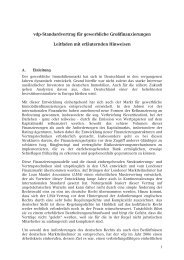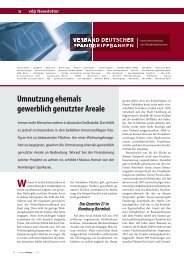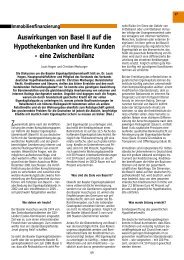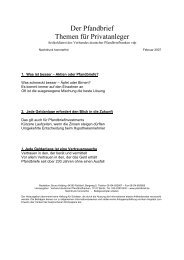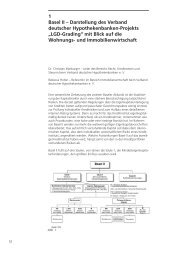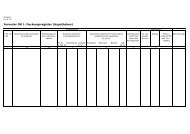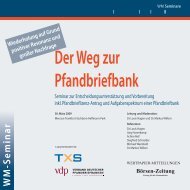The Pfandbrief 2011 | 2012
The Pfandbrief 2011 | 2012
The Pfandbrief 2011 | 2012
Create successful ePaper yourself
Turn your PDF publications into a flip-book with our unique Google optimized e-Paper software.
Counterparty default risk<br />
Mortgage loans are closely related to Mortgage <strong>Pfandbrief</strong>e and are thus frequently regarded<br />
as a substitute. However, the resulting capital requirements under QIS5 were not necessarily<br />
identical. In contrast to <strong>Pfandbrief</strong>e, mortgage loans were allocated to counterparty default<br />
risk. <strong>The</strong> calculation of the capital requirement in this category does not depend directly on the<br />
creditworthiness of the borrower or on the term of the mortgage loan. Instead, it is based on<br />
the relationship between the market value of the security provided (i.e. the property) and the<br />
market value of the loan. <strong>The</strong> capital requirement for a loan that is fully covered by collateral<br />
is around 4% (cf. figure 3). This level is roughly comparable to the capital requirement for a<br />
AAA-rated <strong>Pfandbrief</strong> designed as a zero-coupon bond with a seven-year maturity. This would<br />
render unfounded the concerns sometimes expressed that Solvency II creates significant competitive<br />
advantages for mortgage loans over <strong>Pfandbrief</strong>e. However, this concern remains valid<br />
if one takes into account the fact that the large majority of the <strong>Pfandbrief</strong>e currently issued<br />
have maturities of six to eight years.<br />
Fig. 3:<br />
Counterparty default risk<br />
Counterparty default risk: Capital requirement as percentage of<br />
mortgage loan on market value basis<br />
16%<br />
14%<br />
12%<br />
10%<br />
8%<br />
6%<br />
4%<br />
0%<br />
0% 10% 20% 30% 40% 50% 60% 70% 80% 90% 100% 110% 120% 130%<br />
Ratio: Market value of security (property) / market value of loan<br />
41<br />
However, since the interest rate risk will in future give insurers incentives to increase duration<br />
on the asset side depending on the maturity of their technical liabilities, the above statement<br />
is disputable. This is because duration is ignored in the calculation of counterparty default risk<br />
in the Solvency II standard model. As a consequence, the creation or building up of a portfolio<br />
with long-term mortgage loans gives insurers the opportunity to minimise the capital requirement<br />
for interest rate risk without being punished elsewhere. However, increasing the level of<br />
duration within a <strong>Pfandbrief</strong> portfolio would result in an additional capital requirement in the<br />
spread risk. Investment in long-term government debt from the EEA offers a more favourable<br />
solution. Such investments are subject to no additional costs – neither from the spread risk nor<br />
from the counterparty default risk – beyond the capital requirements of the interest rate risk.




